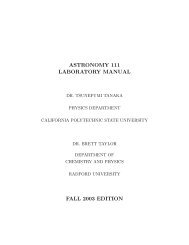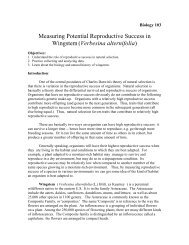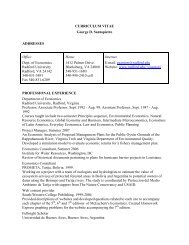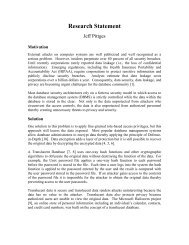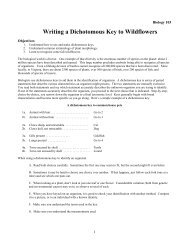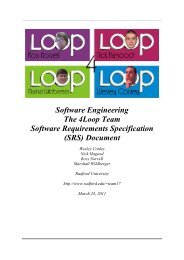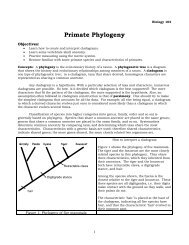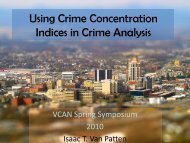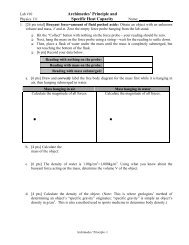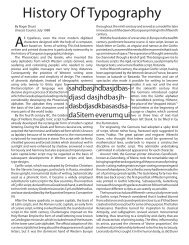application of an expert system for assessment of the short time
application of an expert system for assessment of the short time
application of an expert system for assessment of the short time
Create successful ePaper yourself
Turn your PDF publications into a flip-book with our unique Google optimized e-Paper software.
ITEC 480<br />
Artificial Intelligence<br />
Dr. Maung Maung Htay<br />
Department <strong>of</strong> In<strong>for</strong>mation technology<br />
Rad<strong>for</strong>d University<br />
ITEC 480 1
Text Book <strong>an</strong>d References<br />
Text Book<br />
• Artificial Intelligence: Structures <strong>an</strong>d Strategies<br />
<strong>for</strong> Complex Problem Solving George F. Luger,<br />
Addison Wesley<br />
References<br />
• Artificial Intelligence: A Guide to Intelligent<br />
Systems, Michael Negnevitsky, , Addison Wesley<br />
• Artificial Intelligence: A Modern Approach,<br />
Stuart Russell <strong>an</strong>d Peter Norvig, , Prentice Hall<br />
ITEC 480 2
Import<strong>an</strong>t Research <strong>an</strong>d<br />
Application Areas<br />
• 1 Game Playing<br />
• 2 Automated Reasoning <strong>an</strong>d Theorem Proving<br />
• 3 Expert Systems<br />
• 4 Natural L<strong>an</strong>guage Underst<strong>an</strong>ding <strong>an</strong>d Sem<strong>an</strong>tic Modeling<br />
• 5 Modeling Hum<strong>an</strong> Per<strong>for</strong>m<strong>an</strong>ce<br />
• 6 Pl<strong>an</strong>ning <strong>an</strong>d Robotics<br />
• 7 L<strong>an</strong>guages <strong>an</strong>d Environments <strong>for</strong> AI<br />
• 8 Machine Learning<br />
• 9 Alternative Representations: Neural Nets <strong>an</strong>d Genetic Algorithms<br />
• 10 AI <strong>an</strong>d Philosophy<br />
ITEC 480 3
Import<strong>an</strong>t features <strong>of</strong> Artificial Intelligence:<br />
1. The use <strong>of</strong> computers to do reasoning, pattern recognition, learning, or<br />
some o<strong>the</strong>r <strong>for</strong>m <strong>of</strong> inference.<br />
2. A focus on problems that do not respond to algorithmic solutions. . This<br />
underlies <strong>the</strong> reli<strong>an</strong>ce on heuristic search as <strong>an</strong> AI problem-solving<br />
technique.<br />
3. A concern with problem solving using inexact, missing, or poorly<br />
defined in<strong>for</strong>mation <strong>an</strong>d <strong>the</strong> use <strong>of</strong> representational <strong>for</strong>malisms that t<br />
enable <strong>the</strong> programmer to compensate <strong>for</strong> <strong>the</strong>se problems.<br />
4. Reasoning about <strong>the</strong> signific<strong>an</strong>t qualitative features <strong>of</strong> a situation.<br />
ion.<br />
ITEC 480 4
Import<strong>an</strong>t features <strong>of</strong> Artificial Intelligence: continue<br />
5. An attempt to deal with issues <strong>of</strong> sem<strong>an</strong>tic me<strong>an</strong>ing as well as<br />
syntactic <strong>for</strong>m.<br />
6. Answers that are nei<strong>the</strong>r exact nor optimal, but are in some sense<br />
“sufficient. sufficient.” This is a result <strong>of</strong> <strong>the</strong> essential reli<strong>an</strong>ce on heuristic<br />
problem-solving methods in situations where optimal or exact results<br />
are ei<strong>the</strong>r too expensive or not possible.<br />
7. The use <strong>of</strong> large amounts <strong>of</strong> domain-specific knowledge in solving<br />
problems. This is <strong>the</strong> basis <strong>of</strong> <strong>expert</strong> <strong>system</strong>s.<br />
8. The use <strong>of</strong> meta-level knowledge to effect more sophisticated control<br />
<strong>of</strong> problem solving strategies. Although this is a very difficult problem,<br />
addressed in relatively few current <strong>system</strong>s, it is emerging as <strong>an</strong> a<br />
essential area <strong>of</strong> research.<br />
ITEC 480 5
Introduction to knowledge-base<br />
intelligent <strong>system</strong>s<br />
• Intelligent machines, or what machines c<strong>an</strong> do<br />
• The history <strong>of</strong> artificial intelligence or from <strong>the</strong><br />
“Dark Ages” to knowledge-based <strong>system</strong>s<br />
• Summary<br />
ITEC 480 6
Intelligent machines, or what<br />
machines c<strong>an</strong> do<br />
• Philosophers have been trying <strong>for</strong> over 2000 years<br />
to underst<strong>an</strong>d <strong>an</strong>d resolve two Big Questions <strong>of</strong> <strong>the</strong><br />
Universe: How does a hum<strong>an</strong> mind work, <strong>an</strong>d<br />
C<strong>an</strong> non-hum<strong>an</strong>s have minds? These questions<br />
are still un<strong>an</strong>swered.<br />
• Intelligence is <strong>the</strong>ir ability to underst<strong>an</strong>d <strong>an</strong>d learn<br />
things.<br />
• Intelligence is <strong>the</strong> ability to think <strong>an</strong>d underst<strong>an</strong>d<br />
instead <strong>of</strong> doing things by instinct or automatically.<br />
(Essential English Dictionary, , Collins, London, 1990)<br />
ITEC 480 7
• In order to think, someone<br />
one or something<br />
has to have<br />
a brain, or <strong>an</strong> org<strong>an</strong> that enables someone<br />
one or<br />
something<br />
to learn <strong>an</strong>d underst<strong>an</strong>d things, to solve<br />
problems <strong>an</strong>d to make decisions. So we c<strong>an</strong> define<br />
intelligence as <strong>the</strong> ability to learn <strong>an</strong>d underst<strong>an</strong>d,<br />
to solve problems <strong>an</strong>d to make decisions.<br />
• The goal <strong>of</strong> artificial intelligence (AI) as a science<br />
is to make machines do things that would require<br />
intelligence if done by hum<strong>an</strong>s. There<strong>for</strong>e, <strong>the</strong><br />
<strong>an</strong>swer to <strong>the</strong> question C<strong>an</strong> Machines Think? was<br />
vitally import<strong>an</strong>t to <strong>the</strong> discipline.<br />
• The <strong>an</strong>swer is not a simple “Yes” or “No”.<br />
ITEC 480 8
• Some people are smarter in some ways th<strong>an</strong> o<strong>the</strong>rs.<br />
Some<strong>time</strong>s we make very intelligent decisions but<br />
some<strong>time</strong>s we also make very silly mistakes. Some <strong>of</strong><br />
us deal with complex ma<strong>the</strong>matical <strong>an</strong>d engineering<br />
problems but are moronic in philosophy <strong>an</strong>d history.<br />
• Some people are good at making money, while o<strong>the</strong>rs<br />
are better at spending it. As hum<strong>an</strong>s, we all have <strong>the</strong><br />
ability to learn <strong>an</strong>d underst<strong>an</strong>d, to solve problems <strong>an</strong>d<br />
to make decisions; however, our abilities are not equal<br />
<strong>an</strong>d lie in different areas.<br />
• There<strong>for</strong>e, we should expect that if machines c<strong>an</strong> think,<br />
some <strong>of</strong> <strong>the</strong>m might be smarter th<strong>an</strong> o<strong>the</strong>rs in some<br />
ways.<br />
ITEC 480 9
• One <strong>of</strong> <strong>the</strong> most signific<strong>an</strong>t papers on machine<br />
intelligence, “Computing Machinery <strong>an</strong>d<br />
Intelligence”, , was written by <strong>the</strong> British<br />
ma<strong>the</strong>matici<strong>an</strong> Al<strong>an</strong> Turing over fifty years ago .<br />
However, it still st<strong>an</strong>ds up well under <strong>the</strong> test <strong>of</strong><br />
<strong>time</strong>, <strong>an</strong>d <strong>the</strong> Turing’s s approach remains universal.<br />
• He asked: Is <strong>the</strong>re thought without experience? Is<br />
<strong>the</strong>re mind without communication? Is <strong>the</strong>re<br />
l<strong>an</strong>guage without living? Is <strong>the</strong>re intelligence<br />
without life? All <strong>the</strong>se questions, as you c<strong>an</strong> see,<br />
are just variations on <strong>the</strong> fundamental question <strong>of</strong><br />
artificial intelligence, C<strong>an</strong> machines think?<br />
ITEC 480 10
• Turing did not provide definitions <strong>of</strong> machines <strong>an</strong>d<br />
thinking, he just avoided sem<strong>an</strong>tic arguments by<br />
inventing a game, <strong>the</strong> Turing Imitation Game.<br />
• The imitation game originally included two phases.<br />
In <strong>the</strong> first phase, <strong>the</strong> interrogator, a m<strong>an</strong> <strong>an</strong>d a<br />
wom<strong>an</strong> are each placed in separate rooms. The<br />
interrogator’s s objective is to work out who is <strong>the</strong><br />
m<strong>an</strong> <strong>an</strong>d who is <strong>the</strong> wom<strong>an</strong> by questioning <strong>the</strong>m.<br />
The m<strong>an</strong> should attempt to deceive <strong>the</strong> interrogator<br />
that he is <strong>the</strong> wom<strong>an</strong>, while <strong>the</strong> wom<strong>an</strong> has to<br />
convince <strong>the</strong> interrogator that she is <strong>the</strong> wom<strong>an</strong>.<br />
ITEC 480 11
Turing Imitation Game: Phase 1<br />
ITEC 480 12
Turing Imitation Game: Phase 2<br />
• In <strong>the</strong> second phase <strong>of</strong> <strong>the</strong> game, <strong>the</strong> m<strong>an</strong> is<br />
replaced by a computer programmed to deceive <strong>the</strong><br />
interrogator as <strong>the</strong> m<strong>an</strong> did. It would even be<br />
programmed to make mistakes <strong>an</strong>d provide fuzzy<br />
<strong>an</strong>swers in <strong>the</strong> way a hum<strong>an</strong> would. If <strong>the</strong><br />
computer c<strong>an</strong> fool <strong>the</strong> interrogator as <strong>of</strong>ten as <strong>the</strong><br />
m<strong>an</strong> did, we may say this computer has passed <strong>the</strong><br />
intelligent behaviour test.<br />
ITEC 480 13
Turing Imitation Game: Phase 2<br />
ITEC 480 14
The Turing test has two remarkable qualities<br />
that make it really universal.<br />
• By maintaining communication between <strong>the</strong> hum<strong>an</strong><br />
<strong>an</strong>d <strong>the</strong> machine via terminals, <strong>the</strong> test gives us <strong>an</strong><br />
objective st<strong>an</strong>dard view on intelligence.<br />
• The test itself is quite independent from <strong>the</strong> details<br />
<strong>of</strong> <strong>the</strong> experiment. It c<strong>an</strong> be conducted as a two-<br />
phase game, or even as a single-phase game when<br />
<strong>the</strong> interrogator needs to choose between <strong>the</strong><br />
hum<strong>an</strong> <strong>an</strong>d <strong>the</strong> machine from <strong>the</strong> beginning <strong>of</strong> <strong>the</strong><br />
test.<br />
ITEC 480 15
• Turing believed that by <strong>the</strong> end <strong>of</strong> <strong>the</strong> 20th century<br />
it would be possible to program a digital computer<br />
to play <strong>the</strong> imitation game. Although modern<br />
computers still c<strong>an</strong>not pass <strong>the</strong> Turing test, it<br />
provides a basis <strong>for</strong> <strong>the</strong> verification <strong>an</strong>d validation<br />
<strong>of</strong> knowledge-based <strong>system</strong>s.<br />
• A program thought intelligent in some narrow<br />
area <strong>of</strong> <strong>expert</strong>ise is evaluated by comparing its<br />
per<strong>for</strong>m<strong>an</strong>ce with <strong>the</strong> per<strong>for</strong>m<strong>an</strong>ce <strong>of</strong> a hum<strong>an</strong><br />
<strong>expert</strong>.<br />
• To build <strong>an</strong> intelligent computer <strong>system</strong>, we have to<br />
capture, org<strong>an</strong>ise <strong>an</strong>d use hum<strong>an</strong> <strong>expert</strong> knowledge<br />
in some narrow area <strong>of</strong> <strong>expert</strong>ise.<br />
ITEC 480 16
The history <strong>of</strong> artificial intelligence<br />
The birth <strong>of</strong> artificial intelligence (1943 – 1956)<br />
• The first work recognised in <strong>the</strong> field <strong>of</strong> AI was<br />
presented by Warren McCulloch <strong>an</strong>d Walter<br />
Pitts in 1943. They proposed a model <strong>of</strong> <strong>an</strong><br />
artificial neural network <strong>an</strong>d demonstrated that<br />
simple network structures could learn.<br />
• McCulloch, <strong>the</strong> second “founding fa<strong>the</strong>r” <strong>of</strong> AI<br />
after Al<strong>an</strong> Turing, had created <strong>the</strong> corner stone <strong>of</strong><br />
neural computing <strong>an</strong>d artificial neural networks<br />
(ANN).<br />
ITEC 480 17
• The third founder <strong>of</strong> AI was John von Neum<strong>an</strong>n,<br />
<strong>the</strong> brilli<strong>an</strong>t Hungari<strong>an</strong>-born ma<strong>the</strong>matici<strong>an</strong>. In<br />
1930, he joined <strong>the</strong> Princeton University, lecturing<br />
in ma<strong>the</strong>matical physics. He was <strong>an</strong> adviser <strong>for</strong> <strong>the</strong><br />
Electronic Numerical Integrator <strong>an</strong>d Calculator<br />
project at <strong>the</strong> University <strong>of</strong> Pennsylv<strong>an</strong>ia <strong>an</strong>d<br />
helped to design <strong>the</strong> Electronic Discrete Variable<br />
Calculator. . He was influenced by McCulloch <strong>an</strong>d<br />
Pitts’s s neural network model. When Marvin<br />
Minsky <strong>an</strong>d De<strong>an</strong> Edmonds, , two graduate<br />
students in <strong>the</strong> Princeton ma<strong>the</strong>matics department,<br />
built <strong>the</strong> first neural network computer in 1951, von<br />
Neum<strong>an</strong>n encouraged <strong>an</strong>d supported <strong>the</strong>m.<br />
ITEC 480 18
• Ano<strong>the</strong>r <strong>of</strong> <strong>the</strong> first generation researchers was<br />
Claude Sh<strong>an</strong>non. . He graduated from MIT <strong>an</strong>d<br />
joined Bell Telephone Laboratories in 1941.<br />
Sh<strong>an</strong>non shared Al<strong>an</strong> Turing’s s ideas on <strong>the</strong><br />
possibility <strong>of</strong> machine intelligence. In 1950, he<br />
published a paper on chess-playing machines,<br />
which pointed out that a typical chess game<br />
involved about 10 120 possible moves (Sh<strong>an</strong>non,<br />
1950). Even if <strong>the</strong> new von Neum<strong>an</strong>n-type<br />
computer could examine one move per<br />
microsecond, it would take 3 × 10 106 years to make<br />
its first move. Thus Sh<strong>an</strong>non demonstrated <strong>the</strong><br />
need to use heuristics in <strong>the</strong> search <strong>for</strong> <strong>the</strong> solution.<br />
ITEC 480 19
• In 1956, John McCarthy, Martin Minsky <strong>an</strong>d<br />
Claude Sh<strong>an</strong>non org<strong>an</strong>ised a summer workshop at<br />
Dartmouth College. They brought toge<strong>the</strong>r<br />
researchers interested in <strong>the</strong> study <strong>of</strong> machine<br />
intelligence, artificial neural nets <strong>an</strong>d automata<br />
<strong>the</strong>ory. Although <strong>the</strong>re were just ten researchers,<br />
this workshop gave birth to a new science called<br />
artificial intelligence.<br />
ITEC 480 20
The rise <strong>of</strong> artificial intelligence, or <strong>the</strong> era <strong>of</strong><br />
great expectations (1956 – late 1960s)<br />
• The early works on neural computing <strong>an</strong>d artificial<br />
neural networks started by McCulloch <strong>an</strong>d Pitts<br />
was continued. Learning methods were improved<br />
<strong>an</strong>d Fr<strong>an</strong>k Rosenblatt proved <strong>the</strong> perceptron<br />
convergence <strong>the</strong>orem, , demonstrating that his<br />
learning algorithm could adjust <strong>the</strong> connection<br />
strengths <strong>of</strong> a perceptron.<br />
ITEC 480 21
• One <strong>of</strong> <strong>the</strong> most ambitious projects <strong>of</strong> <strong>the</strong> era <strong>of</strong><br />
great expectations was <strong>the</strong> General Problem<br />
Solver (GPS). Allen Newell <strong>an</strong>d Herbert Simon<br />
from <strong>the</strong> Carnegie Mellon University developed a<br />
general-purpose program to simulate hum<strong>an</strong>-<br />
solving methods.<br />
• Newell <strong>an</strong>d Simon postulated that a problem to be<br />
solved could be defined in terms <strong>of</strong> states. . They<br />
used <strong>the</strong> me<strong>an</strong>-end end <strong>an</strong>alysis to determine a<br />
difference between <strong>the</strong> current <strong>an</strong>d desirable or<br />
goal state <strong>of</strong> <strong>the</strong> problem, <strong>an</strong>d to choose <strong>an</strong>d apply<br />
operators to reach <strong>the</strong> goal state. The set <strong>of</strong><br />
operators determined <strong>the</strong> solution pl<strong>an</strong>.<br />
ITEC 480 22
• However, GPS failed to solve complex problems.<br />
The program was based on <strong>for</strong>mal logic <strong>an</strong>d could<br />
generate <strong>an</strong> infinite number <strong>of</strong> possible operators.<br />
The amount <strong>of</strong> computer <strong>time</strong> <strong>an</strong>d memory that<br />
GPS required to solve real-world problems led to<br />
<strong>the</strong> project being ab<strong>an</strong>doned.<br />
• In <strong>the</strong> sixties, AI researchers attempted to simulate<br />
<strong>the</strong> thinking process by inventing general methods<br />
<strong>for</strong> solving broad classes <strong>of</strong> problems. . They used<br />
<strong>the</strong> general-purpose search mech<strong>an</strong>ism to find a<br />
solution to <strong>the</strong> problem. Such approaches, now<br />
referred to as weak methods, , applied weak<br />
in<strong>for</strong>mation about <strong>the</strong> problem domain.<br />
ITEC 480 23
• By 1970, <strong>the</strong> euphoria about AI was gone, <strong>an</strong>d most<br />
government funding <strong>for</strong> AI projects was c<strong>an</strong>celled.<br />
AI was still a relatively new field, academic in<br />
nature, with few practical <strong>application</strong>s apart from<br />
playing games. So, to <strong>the</strong> outsider, <strong>the</strong> achieved<br />
results would be seen as toys, as no AI <strong>system</strong> at<br />
that <strong>time</strong> could m<strong>an</strong>age real-world problems.<br />
ITEC 480 24
Unfulfilled promises, or <strong>the</strong> impact <strong>of</strong> reality<br />
(late 1960s – early 1970s)<br />
The main difficulties <strong>for</strong> AI in <strong>the</strong> late 1960s were:<br />
• Because AI researchers were developing general<br />
methods <strong>for</strong> broad classes <strong>of</strong> problems, early<br />
programs contained little or even no knowledge<br />
about a problem domain. To solve problems,<br />
programs applied a search strategy by trying out<br />
different combinations <strong>of</strong> small steps, until <strong>the</strong> right<br />
one was found. This approach was quite feasible <strong>for</strong><br />
simple toy problems, , so it seemed reasonable that,<br />
if <strong>the</strong> programs could be “scaled up” to solve large<br />
problems, <strong>the</strong>y would finally succeed.<br />
ITEC 480 25
• M<strong>an</strong>y <strong>of</strong> <strong>the</strong> problems that AI attempted to solve<br />
were too broad <strong>an</strong>d too difficult. . A typical task <strong>for</strong><br />
early AI was machine tr<strong>an</strong>slation. For example, <strong>the</strong><br />
National Research Council, USA, funded <strong>the</strong><br />
tr<strong>an</strong>slation <strong>of</strong> Russi<strong>an</strong> scientific papers after <strong>the</strong><br />
launch <strong>of</strong> <strong>the</strong> first artificial satellite (Sputnik) in<br />
1957. Initially, <strong>the</strong> project team tried simply<br />
replacing Russi<strong>an</strong> words with English, using <strong>an</strong><br />
electronic dictionary. However, it was soon found<br />
that tr<strong>an</strong>slation requires a general underst<strong>an</strong>ding <strong>of</strong><br />
<strong>the</strong> subject to choose <strong>the</strong> correct words. This task<br />
was too difficult. In 1966, all tr<strong>an</strong>slation projects<br />
funded by <strong>the</strong> US government were c<strong>an</strong>celled.<br />
ITEC 480 26
• In 1971, <strong>the</strong> British government also suspended<br />
support <strong>for</strong> AI research. Sir James Lighthill had<br />
been commissioned by <strong>the</strong> Science Research Council<br />
<strong>of</strong> Great Britain to review <strong>the</strong> current state <strong>of</strong> AI. He<br />
did not find <strong>an</strong>y major or even signific<strong>an</strong>t results<br />
from AI research, <strong>an</strong>d <strong>the</strong>re<strong>for</strong>e saw no need to have<br />
a separate science called “artificial intelligence”.<br />
ITEC 480 27
The technology <strong>of</strong> <strong>expert</strong> <strong>system</strong>s, or <strong>the</strong> key to<br />
success (early 1970s – mid-1980s)<br />
• Probably <strong>the</strong> most import<strong>an</strong>t development in <strong>the</strong><br />
seventies was <strong>the</strong> realisation that <strong>the</strong> domain <strong>for</strong><br />
intelligent machines had to be sufficiently<br />
restricted. Previously, AI researchers had believed<br />
that clever search algorithms <strong>an</strong>d reasoning<br />
techniques could be invented to emulate general,<br />
hum<strong>an</strong>-like, problem-solving methods. A general-<br />
purpose search mech<strong>an</strong>ism could rely on<br />
elementary reasoning steps to find complete<br />
solutions <strong>an</strong>d could use weak knowledge about<br />
domain.<br />
ITEC 480 28
• When weak methods failed, researchers finally<br />
realised that <strong>the</strong> only way to deliver practical<br />
results was to solve typical cases in narrow<br />
areas <strong>of</strong> <strong>expert</strong>ise, making large reasoning<br />
steps.<br />
ITEC 480 29
DENDRAL<br />
• DENDRAL was developed at St<strong>an</strong><strong>for</strong>d University to<br />
determine <strong>the</strong> molecular structure <strong>of</strong> Marti<strong>an</strong> soil,<br />
based on <strong>the</strong> mass spectral data provided by a mass<br />
spectrometer. The project was supported by NASA.<br />
Edward Feigenbaum, , Bruce Buch<strong>an</strong><strong>an</strong> (a computer<br />
scientist) <strong>an</strong>d Joshua Lederberg (a Nobel prize winner<br />
in genetics) <strong>for</strong>med a team.<br />
• There was no scientific algorithm <strong>for</strong> mapping <strong>the</strong><br />
mass spectrum into its molecular structure.<br />
Feigenbaum’s job was to incorporate <strong>the</strong> <strong>expert</strong>ise <strong>of</strong><br />
Lederberg into a computer program to make it<br />
per<strong>for</strong>m at a hum<strong>an</strong> <strong>expert</strong> level. Such programs were<br />
later called <strong>expert</strong> <strong>system</strong>s.<br />
ITEC 480 30
• DENDRAL marked a major “paradigm shift” in AI: a<br />
shift from general-purpose, knowledge-sparse weak<br />
methods to domain-specific, knowledge-intensive<br />
techniques.<br />
• The aim <strong>of</strong> <strong>the</strong> project was to develop a computer<br />
program to attain <strong>the</strong> level <strong>of</strong> per<strong>for</strong>m<strong>an</strong>ce <strong>of</strong> <strong>an</strong><br />
experienced hum<strong>an</strong> chemist. Using heuristics in <strong>the</strong><br />
<strong>for</strong>m <strong>of</strong> high-quality specific rules, rules-<strong>of</strong><br />
<strong>of</strong>-thumb , <strong>the</strong><br />
DENDRAL team proved that computers could equal <strong>an</strong><br />
<strong>expert</strong> in narrow, well defined, problem areas.<br />
• The DENDRAL project originated <strong>the</strong> fundamental idea<br />
<strong>of</strong> <strong>expert</strong> <strong>system</strong>s – knowledge engineering, , which<br />
encompassed techniques <strong>of</strong> capturing, <strong>an</strong>alysing <strong>an</strong>d<br />
expressing in rules <strong>an</strong> <strong>expert</strong>’s “know-how”.<br />
ITEC 480 31
MYCIN<br />
• MYCIN was a rule-based <strong>expert</strong> <strong>system</strong> <strong>for</strong> <strong>the</strong><br />
diagnosis <strong>of</strong> infectious blood diseases. It also provided<br />
a doctor with <strong>the</strong>rapeutic advice in a convenient, user-<br />
friendly m<strong>an</strong>ner.<br />
• MYCIN’s knowledge consisted <strong>of</strong> about 450 rules<br />
derived from hum<strong>an</strong> knowledge in a narrow domain<br />
through extensive interviewing <strong>of</strong> <strong>expert</strong>s.<br />
• The knowledge incorporated in <strong>the</strong> <strong>for</strong>m <strong>of</strong> rules was<br />
clearly separated from <strong>the</strong> reasoning mech<strong>an</strong>ism. The<br />
<strong>system</strong> developer could easily m<strong>an</strong>ipulate knowledge<br />
in <strong>the</strong> <strong>system</strong> by inserting or deleting some rules. For<br />
example, a domain-independent independent version <strong>of</strong> MYCIN<br />
called EMYCIN (Empty MYCIN) was later produced.<br />
ITEC 480 32
PROSPECTOR<br />
• PROSPECTOR was <strong>an</strong> <strong>expert</strong> <strong>system</strong> <strong>for</strong> mineral<br />
exploration developed by <strong>the</strong> St<strong>an</strong><strong>for</strong>d Research<br />
Institute. Nine <strong>expert</strong>s contributed <strong>the</strong>ir knowledge <strong>an</strong>d<br />
<strong>expert</strong>ise. PROSPECTOR used a combined structure<br />
that incorporated rules <strong>an</strong>d a sem<strong>an</strong>tic network.<br />
PROSPECTOR had over 1000 rules.<br />
• The user, <strong>an</strong> exploration geologist, was asked to input<br />
<strong>the</strong> characteristics <strong>of</strong> a suspected deposit: <strong>the</strong> geological<br />
setting, structures, kinds <strong>of</strong> rocks <strong>an</strong>d minerals.<br />
PROSPECTOR compared <strong>the</strong>se characteristics with<br />
models <strong>of</strong> ore deposits <strong>an</strong>d made <strong>an</strong> <strong>assessment</strong> <strong>of</strong> <strong>the</strong><br />
suspected mineral deposit. It could also explain <strong>the</strong><br />
steps it used to reach <strong>the</strong> conclusion.<br />
ITEC 480 33
• A 1986 survey reported a remarkable number <strong>of</strong><br />
successful <strong>expert</strong> <strong>system</strong> <strong>application</strong>s in different<br />
areas: chemistry, electronics, engineering, geology,<br />
m<strong>an</strong>agement, medicine, process control <strong>an</strong>d<br />
military science (Waterm<strong>an</strong>, 1986). Although<br />
Waterm<strong>an</strong> found nearly 200 <strong>expert</strong> <strong>system</strong>s, most<br />
<strong>of</strong> <strong>the</strong> <strong>application</strong>s were in <strong>the</strong> field <strong>of</strong> medical<br />
diagnosis. Seven years later a similar survey<br />
reported over 2500 developed <strong>expert</strong> <strong>system</strong>s<br />
(Durkin, 1994). The new growing area was<br />
business <strong>an</strong>d m<strong>an</strong>ufacturing, which accounted <strong>for</strong><br />
about 60% <strong>of</strong> <strong>the</strong> <strong>application</strong>s. Expert <strong>system</strong><br />
technology had clearly matured.<br />
ITEC 480 34
However:<br />
• Expert <strong>system</strong>s are restricted to a very narrow<br />
domain <strong>of</strong> <strong>expert</strong>ise. For example, MYCIN, which<br />
was developed <strong>for</strong> <strong>the</strong> diagnosis <strong>of</strong> infectious blood<br />
diseases, lacks <strong>an</strong>y real knowledge <strong>of</strong> hum<strong>an</strong><br />
physiology. If a patient has more th<strong>an</strong> one disease,<br />
we c<strong>an</strong>not rely on MYCIN. In fact, <strong>the</strong>rapy<br />
prescribed <strong>for</strong> <strong>the</strong> blood disease might even be<br />
harmful because <strong>of</strong> <strong>the</strong> o<strong>the</strong>r disease.<br />
• Expert <strong>system</strong>s c<strong>an</strong> show <strong>the</strong> sequence <strong>of</strong> <strong>the</strong> rules<br />
<strong>the</strong>y applied to reach a solution, but c<strong>an</strong>not relate<br />
accumulated, heuristic knowledge to <strong>an</strong>y deeper<br />
underst<strong>an</strong>ding <strong>of</strong> <strong>the</strong> problem domain.<br />
ITEC 480 35
• Expert <strong>system</strong>s have difficulty in recognising domain<br />
boundaries. When given a task different from <strong>the</strong><br />
typical problems, <strong>an</strong> <strong>expert</strong> <strong>system</strong> might attempt to<br />
solve it <strong>an</strong>d fail in ra<strong>the</strong>r unpredictable ways.<br />
• Heuristic rules represent knowledge in abstract <strong>for</strong>m<br />
<strong>an</strong>d lack even basic underst<strong>an</strong>ding <strong>of</strong> <strong>the</strong> domain<br />
area. It makes <strong>the</strong> task <strong>of</strong> identifying incorrect,<br />
incomplete or inconsistent knowledge difficult.<br />
• Expert <strong>system</strong>s, especially <strong>the</strong> first generation, have<br />
little or no ability to learn from <strong>the</strong>ir experience.<br />
Expert <strong>system</strong>s are built individually <strong>an</strong>d c<strong>an</strong>not be<br />
developed fast. Complex <strong>system</strong>s c<strong>an</strong> take over 30<br />
person-years to build.<br />
ITEC 480 36
How to make a machine learn, or <strong>the</strong> rebirth <strong>of</strong><br />
neural networks (mid-1980s<br />
– onwards)<br />
• In <strong>the</strong> mid-eighties, researchers, engineers <strong>an</strong>d<br />
<strong>expert</strong>s found that building <strong>an</strong> <strong>expert</strong> <strong>system</strong><br />
required much more th<strong>an</strong> just buying a reasoning<br />
<strong>system</strong> or <strong>expert</strong> <strong>system</strong> shell <strong>an</strong>d putting enough<br />
rules in it. Disillusions about <strong>the</strong> applicability <strong>of</strong><br />
<strong>expert</strong> <strong>system</strong> technology even led to people<br />
predicting <strong>an</strong> AI “winter” with severely squeezed<br />
funding <strong>for</strong> AI projects. AI researchers decided to<br />
have a new look at neural networks.<br />
ITEC 480 37
• By <strong>the</strong> late sixties, most <strong>of</strong> <strong>the</strong> basic ideas <strong>an</strong>d<br />
concepts necessary <strong>for</strong> neural computing had<br />
already been <strong>for</strong>mulated. However, only in <strong>the</strong><br />
mid-eighties did <strong>the</strong> solution emerge. The major<br />
reason <strong>for</strong> <strong>the</strong> delay was technological: <strong>the</strong>re were<br />
no PCs or powerful workstations to model <strong>an</strong>d<br />
experiment with artificial neural networks.<br />
• In <strong>the</strong> eighties, because <strong>of</strong> <strong>the</strong> need <strong>for</strong> brain-like<br />
in<strong>for</strong>mation processing, as well as <strong>the</strong> adv<strong>an</strong>ces in<br />
computer technology <strong>an</strong>d progress in neuroscience,<br />
<strong>the</strong> field <strong>of</strong> neural networks experienced a dramatic<br />
resurgence. Major contributions to both <strong>the</strong>ory <strong>an</strong>d<br />
design were made on several fronts.<br />
ITEC 480 38
• Grossberg established a new principle <strong>of</strong> self-<br />
org<strong>an</strong>isation (adaptive(<br />
reson<strong>an</strong>ce <strong>the</strong>ory), which<br />
provided <strong>the</strong> basis <strong>for</strong> a new class <strong>of</strong> neural<br />
networks (Grossberg(<br />
Grossberg, , 1980).<br />
• Hopfield introduced neural networks with feedback<br />
– Hopfield networks, , which attracted much attention<br />
in <strong>the</strong> eighties (Hopfield, 1982).<br />
• Kohonen published a paper on self-org<strong>an</strong>ising maps<br />
(Kohonen,, 1982).<br />
• Barto, , Sutton <strong>an</strong>d Anderson published <strong>the</strong>ir work on<br />
rein<strong>for</strong>cement learning <strong>an</strong>d its <strong>application</strong> in<br />
control (Barto(<br />
et al., 1983).<br />
ITEC 480 39
• But <strong>the</strong> real breakthrough came in 1986 when <strong>the</strong><br />
back-propagation learning algorithm, , first<br />
introduced by Bryson <strong>an</strong>d Ho in 1969 (Bryson &<br />
Ho, 1969), was reinvented by Rumelhart <strong>an</strong>d<br />
McClell<strong>an</strong>d in Parallel Distributed Processing<br />
(1986).<br />
• Artificial neural networks have come a long way<br />
from <strong>the</strong> early models <strong>of</strong> McCulloch <strong>an</strong>d Pitts to <strong>an</strong><br />
interdisciplinary subject with roots in neuroscience,<br />
psychology, ma<strong>the</strong>matics <strong>an</strong>d engineering, <strong>an</strong>d will<br />
continue to develop in both <strong>the</strong>ory <strong>an</strong>d practical<br />
<strong>application</strong>s.<br />
ITEC 480 40
The new era <strong>of</strong> knowledge engineering, or<br />
computing with words (late 1980s – onwards)<br />
• Neural network technology <strong>of</strong>fers more natural<br />
interaction with <strong>the</strong> real world th<strong>an</strong> do <strong>system</strong>s<br />
based on symbolic reasoning. Neural networks c<strong>an</strong><br />
learn, adapt to ch<strong>an</strong>ges in a problem’s s environment,<br />
establish patterns in situations where rules are not<br />
known, <strong>an</strong>d deal with fuzzy or incomplete<br />
in<strong>for</strong>mation. However, <strong>the</strong>y lack expl<strong>an</strong>ation<br />
facilities <strong>an</strong>d usually act as a black box. The<br />
process <strong>of</strong> training neural networks with current<br />
technologies is slow, <strong>an</strong>d frequent retraining c<strong>an</strong><br />
cause serious difficulties.<br />
ITEC 480 41
• Classic <strong>expert</strong> <strong>system</strong>s are especially good <strong>for</strong><br />
closed-<strong>system</strong> <strong>system</strong> <strong>application</strong>s with precise inputs <strong>an</strong>d<br />
logical outputs. They use <strong>expert</strong> knowledge in <strong>the</strong><br />
<strong>for</strong>m <strong>of</strong> rules <strong>an</strong>d, if required, c<strong>an</strong> interact with <strong>the</strong><br />
user to establish a particular fact. A major<br />
drawback is that hum<strong>an</strong> <strong>expert</strong>s c<strong>an</strong>not always<br />
express <strong>the</strong>ir knowledge in terms <strong>of</strong> rules or explain<br />
<strong>the</strong> line <strong>of</strong> <strong>the</strong>ir reasoning. This c<strong>an</strong> prevent <strong>the</strong><br />
<strong>expert</strong> <strong>system</strong> from accumulating <strong>the</strong> necessary<br />
knowledge, <strong>an</strong>d consequently lead to its failure.<br />
ITEC 480 42
• Very import<strong>an</strong>t technology dealing with vague,<br />
imprecise <strong>an</strong>d uncertain knowledge <strong>an</strong>d data is fuzzy<br />
logic.<br />
• Hum<strong>an</strong> <strong>expert</strong>s do not usually think in probability<br />
values, but in such terms as <strong>of</strong>ten, generally,<br />
some<strong>time</strong>s, occasionally <strong>an</strong>d rarely. . Fuzzy logic is<br />
concerned with capturing <strong>the</strong> me<strong>an</strong>ing <strong>of</strong> words,<br />
hum<strong>an</strong> reasoning <strong>an</strong>d decision making. Fuzzy logic<br />
provides <strong>the</strong> way to break through <strong>the</strong> computational<br />
bottlenecks <strong>of</strong> traditional <strong>expert</strong> <strong>system</strong>s.<br />
• At <strong>the</strong> heart <strong>of</strong> fuzzy logic lies <strong>the</strong> concept <strong>of</strong> a<br />
linguistic variable. . The values <strong>of</strong> <strong>the</strong> linguistic<br />
variable are words ra<strong>the</strong>r th<strong>an</strong> numbers.<br />
ITEC 480 43
• Fuzzy logic or fuzzy set <strong>the</strong>ory was introduced by<br />
Pr<strong>of</strong>essor Lotfi Zadeh, , Berkeley’s s electrical<br />
engineering department chairm<strong>an</strong>, in 1965. It<br />
provided a me<strong>an</strong>s <strong>of</strong> computing with words.<br />
However, accept<strong>an</strong>ce <strong>of</strong> fuzzy set <strong>the</strong>ory by <strong>the</strong><br />
technical community was slow <strong>an</strong>d difficult. Part<br />
<strong>of</strong> <strong>the</strong> problem was <strong>the</strong> provocative name – “fuzzy”<br />
– it seemed too light-hearted hearted to be taken seriously.<br />
Eventually, fuzzy <strong>the</strong>ory, ignored in <strong>the</strong> West, was<br />
taken seriously in <strong>the</strong> East – by <strong>the</strong> Jap<strong>an</strong>ese. It has<br />
been used successfully since 1987 in Jap<strong>an</strong>ese-<br />
designed dishwashers, washing machines, air<br />
conditioners, television sets, copiers, <strong>an</strong>d even cars.<br />
ITEC 480 44
Benefits derived from <strong>the</strong> <strong>application</strong> <strong>of</strong> fuzzy<br />
logic models in knowledge-based <strong>an</strong>d<br />
decision-support support <strong>system</strong>s c<strong>an</strong> be summarised<br />
as follows:<br />
• Improved computational power: Fuzzy rule-<br />
based <strong>system</strong>s per<strong>for</strong>m faster th<strong>an</strong> conventional<br />
<strong>expert</strong> <strong>system</strong>s <strong>an</strong>d require fewer rules. A fuzzy<br />
<strong>expert</strong> <strong>system</strong> merges <strong>the</strong> rules, making <strong>the</strong>m more<br />
powerful. Lotfi Zadeh believes that in a few years<br />
most <strong>expert</strong> <strong>system</strong>s will use fuzzy logic to solve<br />
highly nonlinear <strong>an</strong>d computationally difficult<br />
problems.<br />
ITEC 480 45
• Improved cognitive modelling: Fuzzy <strong>system</strong>s allow<br />
<strong>the</strong> encoding <strong>of</strong> knowledge in a <strong>for</strong>m that reflects <strong>the</strong><br />
way <strong>expert</strong>s think about a complex problem. They<br />
usually think in such imprecise terms as high <strong>an</strong>d low,<br />
fast <strong>an</strong>d slow, heavy <strong>an</strong>d light. . In order to build<br />
conventional rules, we need to define <strong>the</strong> crisp<br />
boundaries <strong>for</strong> <strong>the</strong>se terms by breaking down <strong>the</strong><br />
<strong>expert</strong>ise into fragments. This fragmentation leads to<br />
<strong>the</strong> poor per<strong>for</strong>m<strong>an</strong>ce <strong>of</strong> conventional <strong>expert</strong> <strong>system</strong>s<br />
when <strong>the</strong>y deal with complex problems. In contrast,<br />
fuzzy <strong>expert</strong> <strong>system</strong>s model imprecise in<strong>for</strong>mation,<br />
capturing <strong>expert</strong>ise similar to <strong>the</strong> way it is represented<br />
in <strong>the</strong> <strong>expert</strong> mind, <strong>an</strong>d thus improve cognitive<br />
modelling <strong>of</strong> <strong>the</strong> problem.<br />
ITEC 480 46
• The ability to represent multiple <strong>expert</strong>s:<br />
Conventional <strong>expert</strong> <strong>system</strong>s are built <strong>for</strong> a narrow<br />
domain. It makes <strong>the</strong> <strong>system</strong>’s s per<strong>for</strong>m<strong>an</strong>ce fully<br />
dependent on <strong>the</strong> right choice <strong>of</strong> <strong>expert</strong>s. When a<br />
more complex <strong>expert</strong> <strong>system</strong> is being built or when<br />
<strong>expert</strong>ise is not well defined, multiple <strong>expert</strong>s might be<br />
needed. However, multiple <strong>expert</strong>s seldom reach close<br />
agreements; <strong>the</strong>re are <strong>of</strong>ten differences in opinions <strong>an</strong>d<br />
even conflicts. This is especially true in areas, such as<br />
business <strong>an</strong>d m<strong>an</strong>agement, where no simple solution<br />
exists <strong>an</strong>d conflicting views should be taken into<br />
account. Fuzzy <strong>expert</strong> <strong>system</strong>s c<strong>an</strong> help to represent<br />
<strong>the</strong> <strong>expert</strong>ise <strong>of</strong> multiple <strong>expert</strong>s when <strong>the</strong>y have<br />
opposing views.<br />
ITEC 480 47
• Although fuzzy <strong>system</strong>s allow expression <strong>of</strong> <strong>expert</strong><br />
knowledge in a more natural way, <strong>the</strong>y still depend<br />
on <strong>the</strong> rules extracted from <strong>the</strong> <strong>expert</strong>s, <strong>an</strong>d thus<br />
might be smart or dumb. Some <strong>expert</strong>s c<strong>an</strong> provide<br />
very clever fuzzy rules – but some just guess <strong>an</strong>d<br />
may even get <strong>the</strong>m wrong. There<strong>for</strong>e, all rules<br />
must be tested <strong>an</strong>d tuned, which c<strong>an</strong> be a prolonged<br />
<strong>an</strong>d tedious process. For example, it took Hitachi<br />
engineers several years to test <strong>an</strong>d tune only 54<br />
fuzzy rules to guide <strong>the</strong> Sendal Subway System.<br />
ITEC 480 48
• In recent years, several methods based on neural<br />
network technology have been used to search<br />
numerical data <strong>for</strong> fuzzy rules. Adaptive or neural<br />
fuzzy <strong>system</strong>s c<strong>an</strong> find new fuzzy rules, or ch<strong>an</strong>ge<br />
<strong>an</strong>d tune existing ones based on <strong>the</strong> data provided.<br />
In o<strong>the</strong>r words, data in – rules out, or experience in<br />
– common sense out.<br />
ITEC 480 49
Summary<br />
• Expert, neural <strong>an</strong>d fuzzy <strong>system</strong>s have now<br />
matured <strong>an</strong>d been applied to a broad r<strong>an</strong>ge <strong>of</strong><br />
different problems, mainly in engineering,<br />
medicine, fin<strong>an</strong>ce, business <strong>an</strong>d m<strong>an</strong>agement.<br />
• Each technology h<strong>an</strong>dles <strong>the</strong> uncertainty <strong>an</strong>d<br />
ambiguity <strong>of</strong> hum<strong>an</strong> knowledge differently, <strong>an</strong>d<br />
each technology has found its place in knowledge<br />
engineering. They no longer compete; ra<strong>the</strong>r <strong>the</strong>y<br />
complement each o<strong>the</strong>r.<br />
ITEC 480 50
• A synergy <strong>of</strong> <strong>expert</strong> <strong>system</strong>s with fuzzy logic <strong>an</strong>d<br />
neural computing improves adaptability,<br />
robustness, fault-toler<strong>an</strong>ce toler<strong>an</strong>ce <strong>an</strong>d speed <strong>of</strong><br />
knowledge-based <strong>system</strong>s. Besides, computing<br />
with words makes <strong>the</strong>m more “hum<strong>an</strong>”.. It is now<br />
common practice to build intelligent <strong>system</strong>s using<br />
existing <strong>the</strong>ories ra<strong>the</strong>r th<strong>an</strong> to propose new ones,<br />
<strong>an</strong>d to apply <strong>the</strong>se <strong>system</strong>s to real-world problems<br />
ra<strong>the</strong>r th<strong>an</strong> to “toy” problems.<br />
ITEC 480 51
Main events in <strong>the</strong> history <strong>of</strong> AI<br />
Period<br />
The birth <strong>of</strong> Artificial<br />
Intelligence<br />
(1943–1956)<br />
Key Events<br />
McCulloch <strong>an</strong>d Pitts, A Logical Calculus <strong>of</strong> <strong>the</strong> Ideas<br />
Imm<strong>an</strong>ent in Nervous Activity, 1943<br />
Turing, Computing Machinery <strong>an</strong>d Intelligence, 1950<br />
The Electronic Numerical Integrator <strong>an</strong>d Calculator<br />
project (von Neum<strong>an</strong>n)<br />
Sh<strong>an</strong>non, Programming a Computer <strong>for</strong> Playing Chess,<br />
1950<br />
The Dartmouth College summer workshop on machine<br />
intelligence, artificial neural nets <strong>an</strong>d automata <strong>the</strong>ory,<br />
1956<br />
ITEC 480 52
Period<br />
The rise <strong>of</strong> artificial<br />
intelligence<br />
(1956–late 1960s)<br />
Key Events<br />
LISP (McCarthy)<br />
The General Problem Solver (GPR) project (Newell <strong>an</strong>d<br />
Simon)<br />
Newell <strong>an</strong>d Simon, Hum<strong>an</strong> Problem Solving, 1972<br />
Minsky, A Framework <strong>for</strong> Representing Knowledge, 1975<br />
The disillusionment<br />
in artificial<br />
intelligence (late<br />
1960s–early 1970s)<br />
Cook, The Complexity <strong>of</strong> Theorem Proving Procedures,<br />
1971<br />
Karp, Reducibility Among Combinatorial Problems, 1972<br />
The Lighthill Report, 1971<br />
ITEC 480 53
Period<br />
The discovery <strong>of</strong><br />
<strong>expert</strong> <strong>system</strong>s (early<br />
1970s–mid-1980s)<br />
Key Events<br />
DENDRAL (Feigenbaum, Buch<strong>an</strong><strong>an</strong> <strong>an</strong>d Lederberg,<br />
St<strong>an</strong><strong>for</strong>d University)<br />
MYCIN (Feigenbaum <strong>an</strong>d Shortliffe, St<strong>an</strong><strong>for</strong>d University)<br />
PROSPECTOR (St<strong>an</strong><strong>for</strong>d Research Institute)<br />
PROLOG - a logic programming l<strong>an</strong>guage (Colmerauer,<br />
Roussel <strong>an</strong>d Kowalski, Fr<strong>an</strong>ce)<br />
EMYCIN (St<strong>an</strong><strong>for</strong>d University)<br />
Waterm<strong>an</strong>, A Guide to Expert Systems, 1986<br />
ITEC 480 54
Period<br />
The rebirth <strong>of</strong><br />
artificial neural<br />
networks<br />
(1965–onwards)<br />
Key Events<br />
Hopfield, Neural Networks <strong>an</strong>d Physical Systems with<br />
Emergent Collective Computational Abilities, 1982<br />
Kohonen, Self-Org<strong>an</strong>ized Formation <strong>of</strong> Topologically<br />
Correct Feature Maps, 1982<br />
Rumelhart <strong>an</strong>d McClell<strong>an</strong>d, Parallel Distributed<br />
Processing, 1986<br />
The First IEEE International Conference on Neural<br />
Networks, 1987<br />
Haykin, Neural Networks, 1994<br />
Neural Network, MATLAB Application Toolbox (The<br />
MathWork, Inc.)<br />
ITEC 480 55
Period<br />
Evolutionary<br />
computation (early<br />
1970s–onwards)<br />
Key Events<br />
Rechenberg, Evolutionsstrategien - Optimierung<br />
Technischer Systeme Nach Prinzipien der Biologischen<br />
In<strong>for</strong>mation, 1973<br />
Holl<strong>an</strong>d, Adaptation in Natural <strong>an</strong>d Artificial Systems,<br />
1975.<br />
Koza, Genetic Programming: On <strong>the</strong> Programming <strong>of</strong> <strong>the</strong><br />
Computers by Me<strong>an</strong>s <strong>of</strong> Natural Selection, 1992.<br />
Schwefel, Evolution <strong>an</strong>d Optimum Seeking, 1995<br />
Fogel, Evolutionary Computation –Towards a New<br />
Philosophy <strong>of</strong> Machine Intelligence, 1995.<br />
ITEC 480 56
Period<br />
Computing with<br />
Words<br />
(late 1980s–onwards)<br />
Key Events<br />
Zadeh, Fuzzy Sets, 1965<br />
Zadeh, Fuzzy Algorithms, 1969<br />
Mamd<strong>an</strong>i, Application <strong>of</strong> Fuzzy Logic to Approximate<br />
Reasoning Using Linguistic Syn<strong>the</strong>sis, 1977<br />
Sugeno, Fuzzy Theory, 1983<br />
Jap<strong>an</strong>ese “fuzzy” consumer products (dishwashers,<br />
washing machines, air conditioners, television sets,<br />
copiers)<br />
Sendai Subway System (Hitachi, Jap<strong>an</strong>), 1986<br />
The First IEEE International Conference on Fuzzy<br />
Systems, 1992<br />
Kosko, Neural Networks <strong>an</strong>d Fuzzy Systems, 1992<br />
Kosko, Fuzzy Thinking, 1993<br />
Cox, The Fuzzy Systems H<strong>an</strong>dbook, 1994<br />
Zadeh, Computing with Words - A Paradigm Shift, 1996<br />
Fuzzy Logic, MATLAB Application Toolbox (The<br />
MathWork, Inc.)<br />
ITEC 480 57



